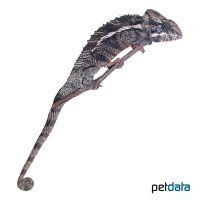Spiny Chameleon (Furcifer verrucosus)
| Spiny Chameleon Furcifer verrucosus | |
|---|---|
| Name | Spiny Chameleon |
| Name Lat. | Furcifer verrucosus |
| Family | Chameleons |
| Family lat. | Chamaeleonidae |
| Order | Scaled Reptiles |
| Order lat. | Squamata |
| Origin | Madagascar |
| Habitat | Humid savanna |
| Diet | Insects |
| Humidity | 60-90 % |
| Behavior | Aggressive |
| Keeping | Individual |
| Care Level | Easy |
| Reproduction | Oviparous |
| Housing | Humid terrarium |
| Life Span | 10 years |
| Protection | CITES Appendix II; EU Annex B |
| Metric Units | |
| Size | 35-60 cm |
| Temperature | 26-28 °C |
| Temperature Local | 33-35 °C |
| Housing Size | 120 x 60 x 120 cm |
| US Units | |
| Size | 14"-24" |
| Temperature | 79-82 °F |
| Temperature Local | 91-95 °F |
| Housing Size | 45" x 25" x 45" |
Distribution and habitat
The predominantly ground-dwelling, diurnal warty chameleons are widespread in the south and west of Madagascar. They live at the sparse forest edges and in the bush savannahs, where they prefer to stay on the ground and in low bushes.
Maintenance
Minimum dimensions for the terrarium, according to the size and number of animals
| 1 animal | 4KRL x 2,5KRL x 4KRL (L x W x H) |
Head-torso length (KRL) is measured on the largest animal. For each additional animal, increase the footprint by 20%. A terrarium of e.g. L 120 x W 60 x H 120 cm is recommended, which should be placed in a quiet and vibration-free place.
You need a well ventilated terrarium, structured with branched climbing branches as well as robust (also artificial) plants as a screen, structured back and side walls (e.g. cork covering), a substrate of sand-peat mixture or terrarium humus (15 cm deep) and a small water container or better a dripper. A larger part of the substrate should always be kept slightly moist. Once a day, preferably in the evening, the inside of the terrarium should be finely sprayed with water (humidity). A rain or mist system is ideal.
| Temp. day: 26-28 °C | Temp. night: 22-24 °C | Temp. local: up to 35 °C | Humidity: 60-90 |
The lighting duration must be 10-14 hrs. depending on the season. They need a high light intensity. Special lamps with high UV-A and UV-B content are ideal, because daily UV irradiation is essential.
Diet
The food supply consists of live insects, such as crickets, grasshoppers, cockroaches and crickets. It is often possible to switch to commercially available ready-made food for insectivorous reptiles, which must be offered with tweezers. Wax moths should be fed infrequently and in very small amounts because of their large fat content. Regular addition of minerals and vitamins (dusting the food) is important. Since water is almost only absorbed in drop form from leaves or furnishings, a dropper is recommended, alternatively they can be watered daily from a pipette
A varied diet promotes health and prevents deficiency symptoms.
Reproduction and breeding
The male has a thickened tail root with a clearly visible hemipenis pouch.
The female buries her eggs (up to 45 pieces) in the substrate, which must accordingly consist of a substrate suitable for burrowing. The incubation period is 150-200 days at a temperature of 25-28 °C. Small insects such as fruit flies and micro crickets are suitable as initial food for the young
The life expectancy can be up to 10 years.
Species protection
The animal population must be reported to the competent authority in writing immediately after the start of keeping. Your pet store will be happy to provide you with further information.
Protection of species: WA Appendix II; EU Appendix B. The proof of purchase is the required proof of origin for the animal. Please keep it safe!
Important
When temperatures are too high, the warty chameleon cools itself in earth pits it has dug itself
They need 33-35 °C warm sunny places. For the resting phase, the lighting duration is reduced by 2-3 hours and the temperature is lowered by 4-6 °C for approx. two months.
With fruit and honey water as food for the feeders, their quality can be upgraded.
The terrarium must have good ventilation without drafts and meet the species specific needs. Measuring devices such as thermometers, hygrometers, etc. are necessary. The lighting has to correspond to the species-specific day-night rhythm and has to be placed in such a way that the animals cannot injure themselves. The terrarium should be locked in such a way that neither unauthorized persons can open it nor the animals can escape. Contamination must be removed regularly
Further literature can be found in your pet store.
References
Text: Christian Sänger; Image: petdata
Source: BMELV (1997): Mindestanforderungen an die Haltung von Reptilien; ENGELMANN (2006): Zootierhaltung - Tiere in menschlicher Obhut: Reptilien und Amphibien, Harri Deutsch Verlag
- Gemäß § 21 Abs. 5 Tierschutzgesetz idgF
